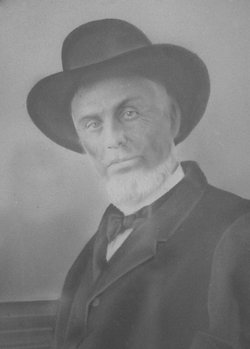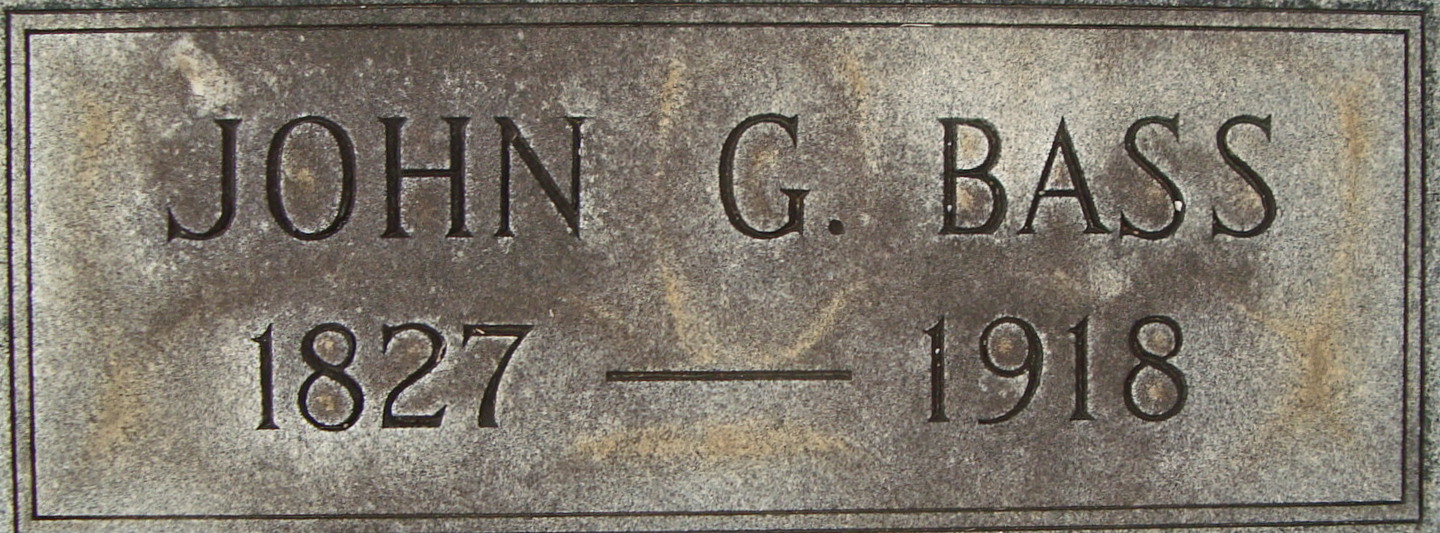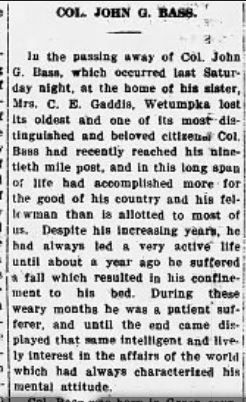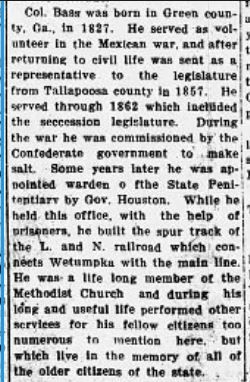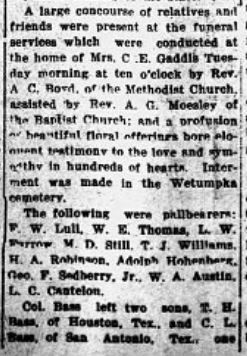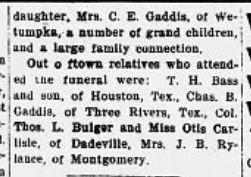From "Gaddis and Kindred Families" by Tweency C Gaddis
Col. Bass was one of the few survivors who served in the Mexican War, going as a Volunteer. In 1867 he was sent as representative to the Legislature from Tallapoosa County, Alabama. During the Civil War, he was commissioned by the Confederate government to make salt at St. Andrews Bay, Florida. During Governor Huston's administration he was appointed Warden of the State Penitentiary at Wetumpka, Alabama. While in the office he built the spur track of the L. & N. Railroad which connects Wetumpka to the main line.
Newspaper Article in Montgomery Advertiser "Along Route 14" no date
By Jeffrey C. Benton Special to the Advertiser
In early 1840, construction on Alabama's first penitentiary began on the Coosa River just more than a mile north of Wetumpka. It was ready to receive prisoners in late 1841.
The three acre complex consisted of three brick buildings enclosed on three sides by a 30 foot high brick wall supported by massive engaged buttresses. The main building, facing east was three storied.
Landscaped grounds, a rose garden, a fountain, and the ornate, two storied galleries that ran across the front of this building concealed its use: guard rooms, offices, warden's residence and cell blocks.
The two cell blocks were at either end of the central building. Each of the cell blocks had four tiers of one man closet size cells. The total capacity was 416 prisoners.
On the western and northern sides of the enclosed prison yard were a chapel, dinning room, kitchen, shops, stables and barn.
In the center of the yard stood the brick hospital and wooden bath and laundry house.
The prison proved costly, and the public was dissatisfied. Acquisition and construction were to have cost $30,000, but they were actually $84,000.
Consequently, the prison was leased.
Three leases were granted between 1845 and 1862. No lessee was able to make money, and the system ended temporarily when a convict killed Dr. Ambrose Burrows, the prison lessee, with an ax blow to the head.
The killer was hanged in the prison yard in front of the other prisoners.
During the Civil War, as manpower became scarce, prisoners who volunteered for military service were released.
Those who remained manufactured war materials. In 1865, Union forces released the remaining prisoners. Only one refused to go, waiting for what he considered to be proper authority to release him.
The following year, the prison was leased again, and convict laborers were contracted to work outside the prison.
This practice proved unsatisfactory, and the convict leasing system was slightly reformed in 1873 when it was noted that "unless they were better cared for they would all soon die".
The convict lease system was condemned by some of the state's most prominent ministers and probably more effectively by the Alabama League of Women Voters and Julia Tutwiler.
Leasing convicts were abolished in 1923, and all prisoners were housed in state facilities in 1927. The old state penitentiary's male prisoners were removed to the first Kilby Prison in 1923.
Female prisoners remained until 1942 when Julia Tutwiler Prison opened. They maintained the prison's gardens and poultry farm and made clothing for the state convicts.
Today the old Alabama State Penitentiary or the Walls, is merely a show of itself. The impressive central building was demolished in 1957. Only the massive buttresses and two long brick buildings survived.
Assume Montgomery newspaper date August 5, 1993
Wetumpka Files Grant Application to Purchase State's First Prison
by Gerald Williams
In a special meeting July 30, the Wetumpka City Council approved a resolution authorizing mayor Alma Leak to file application for a Federal 9-10 grant to purchase the old prison site located on Highway 231 North.
Elmore County has agreed to sell the remains of Alabama's first prison and 3.1 acres for its appraised value of $50,000. Mayor Leak said the grant is for $40,000.
Wetumpka was chosen as the site for the first penitentiary in 1839. It was built by W.H. Thomas for $84,999. Construction began on March 14, 1840 and was completed on October 27, 1841.
The layout of the buildings was impressive, handsome and functional. There were three structures: a long cell block to the north; the back (chiefly administrative) building to the west facing Highway 231; and the entrance building on the south, surrounding a rectangular courtyard. The outer compound was enclosed by high walls on three sides and lower one at the front.
Peculiar as it may seem, in view of the property's present condition and in light of contemporary utilitarian theories of design for correction institutions, the prison at Wetumpka was an attractive complex, ornamented with cast iron grillwork, pool and statuary and landscaping and until about 1940 something of a showplace.
The buildings are masonry; the entrance building (now demolished) was a three story brick with portico, balustrades and double exterior staircase. The cell block was two story, with two story verandah, exterior stairs and wood ornamentation. The back building was also individual and ornate and retains some indication of the past elegance.
The exterior walls were brick, several feet thick with pilasters. The two remaining buildings are badly deteriorated and the yard has been used for industrial operations, which have completely destroyed evidence of gardens and landscaping of the prison grounds.
Although the financial situation of the prison was never satisfactory, and it was subjected to a rapid turnover of wardens, only one or two of whom were good administrators, the place itself in intimately bound up with the history of Wetumpka and Alabama.
Throughout the Civil War the prison wither supplied men for the Confederate Forces or manufactured goods for the use of the Army, until Federal Troops reached the prison and released the inmates in 1865. However, one convict named Morooney refused to leave and remained alone, faithfully guarding the prison until he was released by proper authorities.
Subsequently, the buildings were used for the states' women prison until the completion of Julia Tutwiler in 1942.
Following the meeting Mayor Leak said the city was looking into what grants are available for a feasibility study and restoration of the penitentiary.
From Paula Bass Youngblood
Here is something that Uncle Frank Myron Bass wrote about John and James.
"The grandparents stayed with us several months and then moved on to Athens, TX to stay with Uncle John, Aunt Pearl, and Tennie Mae. Leon and I would go to Athens almost every summer to visit too. I recall being there at the railroad station when Grandpa met his brother John from Tennessee. (It probably should be AL) Both had snow white hair and beards, and they had not seen one another in forty years. It was very touching to see tears rolling down the cheeks of both as they embraced there on the railroad platform."
COL. JOHN G. BASS DEAD.
Colonel Bass was the eldest citizen of this place. His death occurred on last Saturday night at the home of his daughter, Mrs. C .E. Gaddis in West Wetumpka. He was a most distinguished and beloved man by all who knew him.
His children, grand children and great grand children recently met at the home of Mrs. Gaddis to celebrate his ninetieth birthday. During all these years, he has accomplished much good for his country and his fellow man. He had always led a very active life until about a year ago, he had a fall (broke his hip). He never recovered from this and was confined to his bed until the end came. He bore his sufferings with great fortitude and patience, but never failed to display his interest in the affairs of the world.
Colonel Bass was born in Green County, Georgia, and was one of the few survivors who served in the Mexican war, going as a volunteer. In the year 1867 he was sent as representative to the legislature from Tallapoosa County. During the Civil war he was commissioned by the Confederate government to make salt. During Governor Houston's administration he was appointed warden of the state penitentiary. While in this office he built the spur track of the L. and N. railroad which connects Wetumpka to the main line. He was a life long member of the Methodist church and his good deeds to his fellow man will ever live in the memory of the older citizens of the state. Funeral services were conducted at the home of Mrs. Gaddis on Tuesday morning by Rev. A. C. Boyd of the Methodist church, assisted by Rev. A. G. Moseley of the Baptist church. The funeral was attended by a large concourse of relatives and friends. Interment was made in the Wetumpka cemetery. The pall bearers were as follows: F. W. Lull, W. E.Thomas, M. D. Still, Y. J. Williams, L. W. Farrow, H. A. Robison, Adolph Hohenberg, Geo. F. Sedberry, Jr., W. A. Austin, L. C. Cantelou.
Colonel Bass is survived by two sons, T. H. Bass of Houston, Texas, and C. L. Bass of San Antonio, Texas, one daughter, Mrs. C. E. Gaddis of Wetumpka, a number of grand children and a large family connection.
Out of town relatives who attended the funeral were: T. H. Bass and son, Charles B. Gaddis of Three Rivers, Texas, Col. Thomas L. Bulger and Miss Otis Carlisle of Dadeville,. and Mrs. J. B. Roylance of Montgomery.
From "Gaddis and Kindred Families" by Tweency C Gaddis
Col. Bass was one of the few survivors who served in the Mexican War, going as a Volunteer. In 1867 he was sent as representative to the Legislature from Tallapoosa County, Alabama. During the Civil War, he was commissioned by the Confederate government to make salt at St. Andrews Bay, Florida. During Governor Huston's administration he was appointed Warden of the State Penitentiary at Wetumpka, Alabama. While in the office he built the spur track of the L. & N. Railroad which connects Wetumpka to the main line.
Newspaper Article in Montgomery Advertiser "Along Route 14" no date
By Jeffrey C. Benton Special to the Advertiser
In early 1840, construction on Alabama's first penitentiary began on the Coosa River just more than a mile north of Wetumpka. It was ready to receive prisoners in late 1841.
The three acre complex consisted of three brick buildings enclosed on three sides by a 30 foot high brick wall supported by massive engaged buttresses. The main building, facing east was three storied.
Landscaped grounds, a rose garden, a fountain, and the ornate, two storied galleries that ran across the front of this building concealed its use: guard rooms, offices, warden's residence and cell blocks.
The two cell blocks were at either end of the central building. Each of the cell blocks had four tiers of one man closet size cells. The total capacity was 416 prisoners.
On the western and northern sides of the enclosed prison yard were a chapel, dinning room, kitchen, shops, stables and barn.
In the center of the yard stood the brick hospital and wooden bath and laundry house.
The prison proved costly, and the public was dissatisfied. Acquisition and construction were to have cost $30,000, but they were actually $84,000.
Consequently, the prison was leased.
Three leases were granted between 1845 and 1862. No lessee was able to make money, and the system ended temporarily when a convict killed Dr. Ambrose Burrows, the prison lessee, with an ax blow to the head.
The killer was hanged in the prison yard in front of the other prisoners.
During the Civil War, as manpower became scarce, prisoners who volunteered for military service were released.
Those who remained manufactured war materials. In 1865, Union forces released the remaining prisoners. Only one refused to go, waiting for what he considered to be proper authority to release him.
The following year, the prison was leased again, and convict laborers were contracted to work outside the prison.
This practice proved unsatisfactory, and the convict leasing system was slightly reformed in 1873 when it was noted that "unless they were better cared for they would all soon die".
The convict lease system was condemned by some of the state's most prominent ministers and probably more effectively by the Alabama League of Women Voters and Julia Tutwiler.
Leasing convicts were abolished in 1923, and all prisoners were housed in state facilities in 1927. The old state penitentiary's male prisoners were removed to the first Kilby Prison in 1923.
Female prisoners remained until 1942 when Julia Tutwiler Prison opened. They maintained the prison's gardens and poultry farm and made clothing for the state convicts.
Today the old Alabama State Penitentiary or the Walls, is merely a show of itself. The impressive central building was demolished in 1957. Only the massive buttresses and two long brick buildings survived.
Assume Montgomery newspaper date August 5, 1993
Wetumpka Files Grant Application to Purchase State's First Prison
by Gerald Williams
In a special meeting July 30, the Wetumpka City Council approved a resolution authorizing mayor Alma Leak to file application for a Federal 9-10 grant to purchase the old prison site located on Highway 231 North.
Elmore County has agreed to sell the remains of Alabama's first prison and 3.1 acres for its appraised value of $50,000. Mayor Leak said the grant is for $40,000.
Wetumpka was chosen as the site for the first penitentiary in 1839. It was built by W.H. Thomas for $84,999. Construction began on March 14, 1840 and was completed on October 27, 1841.
The layout of the buildings was impressive, handsome and functional. There were three structures: a long cell block to the north; the back (chiefly administrative) building to the west facing Highway 231; and the entrance building on the south, surrounding a rectangular courtyard. The outer compound was enclosed by high walls on three sides and lower one at the front.
Peculiar as it may seem, in view of the property's present condition and in light of contemporary utilitarian theories of design for correction institutions, the prison at Wetumpka was an attractive complex, ornamented with cast iron grillwork, pool and statuary and landscaping and until about 1940 something of a showplace.
The buildings are masonry; the entrance building (now demolished) was a three story brick with portico, balustrades and double exterior staircase. The cell block was two story, with two story verandah, exterior stairs and wood ornamentation. The back building was also individual and ornate and retains some indication of the past elegance.
The exterior walls were brick, several feet thick with pilasters. The two remaining buildings are badly deteriorated and the yard has been used for industrial operations, which have completely destroyed evidence of gardens and landscaping of the prison grounds.
Although the financial situation of the prison was never satisfactory, and it was subjected to a rapid turnover of wardens, only one or two of whom were good administrators, the place itself in intimately bound up with the history of Wetumpka and Alabama.
Throughout the Civil War the prison wither supplied men for the Confederate Forces or manufactured goods for the use of the Army, until Federal Troops reached the prison and released the inmates in 1865. However, one convict named Morooney refused to leave and remained alone, faithfully guarding the prison until he was released by proper authorities.
Subsequently, the buildings were used for the states' women prison until the completion of Julia Tutwiler in 1942.
Following the meeting Mayor Leak said the city was looking into what grants are available for a feasibility study and restoration of the penitentiary.
From Paula Bass Youngblood
Here is something that Uncle Frank Myron Bass wrote about John and James.
"The grandparents stayed with us several months and then moved on to Athens, TX to stay with Uncle John, Aunt Pearl, and Tennie Mae. Leon and I would go to Athens almost every summer to visit too. I recall being there at the railroad station when Grandpa met his brother John from Tennessee. (It probably should be AL) Both had snow white hair and beards, and they had not seen one another in forty years. It was very touching to see tears rolling down the cheeks of both as they embraced there on the railroad platform."
COL. JOHN G. BASS DEAD.
Colonel Bass was the eldest citizen of this place. His death occurred on last Saturday night at the home of his daughter, Mrs. C .E. Gaddis in West Wetumpka. He was a most distinguished and beloved man by all who knew him.
His children, grand children and great grand children recently met at the home of Mrs. Gaddis to celebrate his ninetieth birthday. During all these years, he has accomplished much good for his country and his fellow man. He had always led a very active life until about a year ago, he had a fall (broke his hip). He never recovered from this and was confined to his bed until the end came. He bore his sufferings with great fortitude and patience, but never failed to display his interest in the affairs of the world.
Colonel Bass was born in Green County, Georgia, and was one of the few survivors who served in the Mexican war, going as a volunteer. In the year 1867 he was sent as representative to the legislature from Tallapoosa County. During the Civil war he was commissioned by the Confederate government to make salt. During Governor Houston's administration he was appointed warden of the state penitentiary. While in this office he built the spur track of the L. and N. railroad which connects Wetumpka to the main line. He was a life long member of the Methodist church and his good deeds to his fellow man will ever live in the memory of the older citizens of the state. Funeral services were conducted at the home of Mrs. Gaddis on Tuesday morning by Rev. A. C. Boyd of the Methodist church, assisted by Rev. A. G. Moseley of the Baptist church. The funeral was attended by a large concourse of relatives and friends. Interment was made in the Wetumpka cemetery. The pall bearers were as follows: F. W. Lull, W. E.Thomas, M. D. Still, Y. J. Williams, L. W. Farrow, H. A. Robison, Adolph Hohenberg, Geo. F. Sedberry, Jr., W. A. Austin, L. C. Cantelou.
Colonel Bass is survived by two sons, T. H. Bass of Houston, Texas, and C. L. Bass of San Antonio, Texas, one daughter, Mrs. C. E. Gaddis of Wetumpka, a number of grand children and a large family connection.
Out of town relatives who attended the funeral were: T. H. Bass and son, Charles B. Gaddis of Three Rivers, Texas, Col. Thomas L. Bulger and Miss Otis Carlisle of Dadeville,. and Mrs. J. B. Roylance of Montgomery.
Family Members
Sponsored by Ancestry
Advertisement
Explore more
Sponsored by Ancestry
Advertisement
